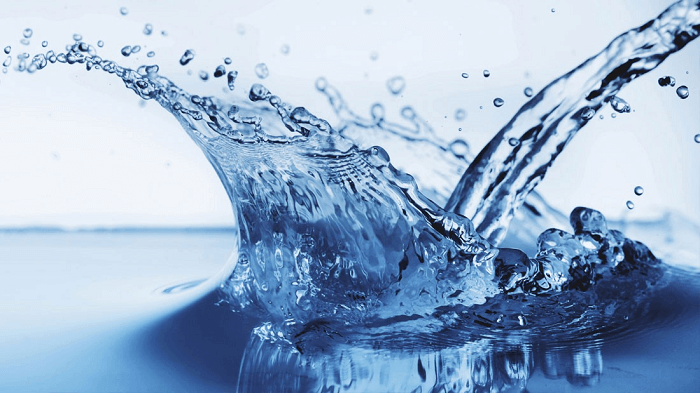Water DefinitionTwo hydrogen atoms are joined to the central oxygen atom by a covalent bond to form the chemical compound known as water (H2O). A molecule that has this configuration is polar. As a result of polarization, a water molecule's electropositive hydrogen and electronegative oxygen atoms are electrostatically drawn to one another. "Hydrogen bond" refers to the electrostatic dipole-dipole interaction between water molecules. Transient hydrogen bonding between water molecules results in the formation of a clear, tasteless, odorless liquid. Water can also exist in other states besides liquid, such as gas (as water vapor) and solid (as ice). The unique characteristics of water, including its high boiling point (100 °C), high surface tension, specific heat, and heat of vaporization, are caused by hydrogen bonds between its molecules. Properties of WaterSpecifically, water is recognized as a universal solvent because of its physical and chemical properties. It is one of the main inorganic chemicals with biological significance, along with carbon dioxide, oxygen, salts, and mineral substances. The following is a list of some of water's distinguishing characteristics:
Water is a Polar MoleculeOne centrally situated oxygen atom and two attached, smaller hydrogen atoms comprise a water molecule. Each of these hydrogen atoms has a covalent link with oxygen, and there are both partially positive and partially negative poles (thus, making water a polar molecule). In addition to the covalent link, a short hydrogen bond is created with a nearby water molecule, and water molecules form hydrogen bonds with one another. Because the oxygen in water has a small negative charge and the hydrogen atoms have a slight positive charge, water is a polar molecule. It is an excellent solvent for many compounds due to its polarity. Anions are drawn to the hydrogen, which is slightly positive, while cations are drawn to the slightly negative oxygen. Hence, water can ionize and dissociate molecules. Heightened Surface TensionWater has a relatively high surface tension. So, compared to the molecules in the air(due to adhesion), the water molecules are more attracted to one another due to cohesion. Due to its low viscosity, water flows with little resistance. By reducing the rate of water loss from the leaf stomata, these characteristics are vital to plants. The high surface tension of water allows insects that can walk on it to do so. Adhesion CharacteristicsWater has excellent adhesive qualities. As a result, vascular plants like trees rely on water's ability for capillary action, which is the inclination to travel up a small tube against gravity. Specific Heat PropertiesThe second-highest specific heat capacity is found in water (after ammonia). To raise the temperature of one gram of a pure substance by one degree Celsius, a certain quantity of energy (measured in calories or joules) must be expended. The water's high specific heat contributes to keeping Earth's atmosphere habitable. For instance, during the day, the ocean absorbs a large portion of solar energy, which it subsequently releases into the atmosphere at night. Biologic SignificanceOne of the elements required for life is water. Gases, vitamins, and biomolecules (DNA, proteins, or polysaccharides) can all dissolve in water. These compounds may be transported to different areas of the body using water as a transport medium. Moreover, it serves as a significant reactant in other biological processes. Water is a crucial component of photosynthesis in plants. Since water molecules can make temporary hydrogen bonds with one another and are polar, they can help create biomolecular structures like DNA and proteins. The fact that water may interact with ions, as well as other polar molecules, is also a result of its polarity. 
Water has a crucial role in ionizing chemicals and consequently aids in controlling pH levels. Hydrophilic molecules or compounds are those that are easily soluble in water. On the other hand, substances that are difficult to dissolve in water are called hydrophobic and are claimed to be nonpolar & difficult to dissolve in water. The lipid-bilayer plasma membrane's structure and operation depend heavily on water's interactions with polar and nonpolar molecules. The most prevalent molecule inside a cell is water, which makes up at least 70% of the total mass of the cell. The cell's cytosol contains water, ions, solutes, and other molecules. Body water is the term for the liquid that makes up an individual's body. It is found virtually everywhere in the tissues, including the bones, muscles, adipose tissue, and blood. About 50 to 60 percent of the average adult body is water; a newborn baby's body contains more water than an adult's (up to 93% of the body weight). Extracellular and intracellular fluids are two examples of biological fluids containing body water in humans and animals. The extracellular fluid makes about 1/3 of the body's water and is found in body tissues outside cells. The liquids inside cells are known as intracellular fluids, making up almost two-thirds of the body's water. There is a lot of water on Earth, and it can be either a solid, liquid, or gas, and water covers over 70% of the Earth's surface. On Earth, bodies of water act as vital habitats for aquatic life and as a water source for terrestrial life. Marine water, freshwater, & salty water are the three main categories of aquatic environments. Usage of the Term WaterThe term "water" can refer to a material, such as a body of water like the sea, rivers, or lakes, or naturally occurring water, such as mineral water, in addition to being classified as a substance with the chemical formula H2O. It may also apply to the aqueous material solution, such as wastewater or ammonia water. It is also a slang name for amniotic fluid, a fluid leakage that occurs just before or while labor starts and before the amnion ruptures. Significant Facts about Water
Next TopicWeb Browser Definition
|
 For Videos Join Our Youtube Channel: Join Now
For Videos Join Our Youtube Channel: Join Now
Feedback
- Send your Feedback to [email protected]
Help Others, Please Share









